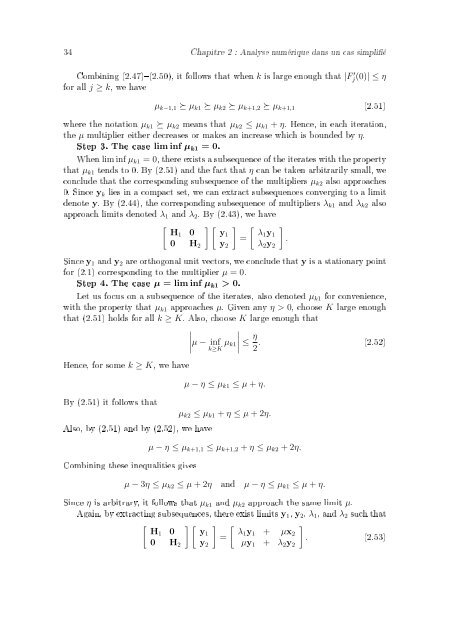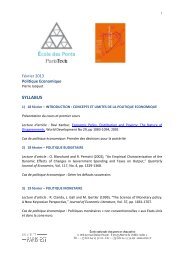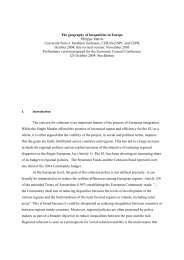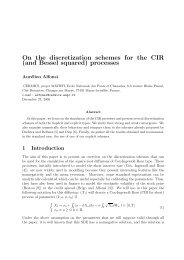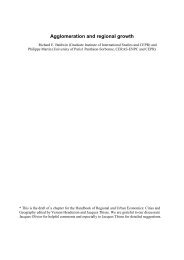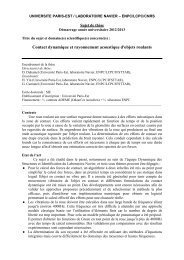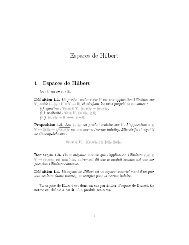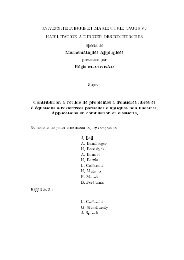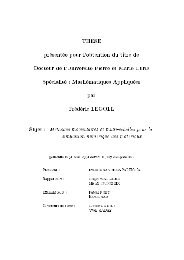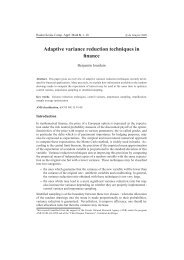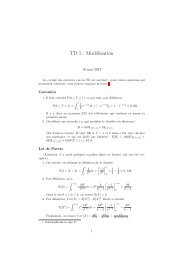You also want an ePaper? Increase the reach of your titles
YUMPU automatically turns print PDFs into web optimized ePapers that Google loves.
34 Chapitre 2 : Analyse numérique dans un cas simplié<br />
Combining (2.47)(2.50), it follows that when k is large enough that |F j(0)| ′ ≤ η<br />
for all j ≥ k, we have<br />
µ k−1,1 ≽ µ k1 ≽ µ k2 ≽ µ k+1,2 ≽ µ k+1,1 (2.51)<br />
where the notation µ k1 ≽ µ k2 means that µ k2 ≤ µ k1 + η. Hence, in each iteration,<br />
the µ multiplier either decreases or makes an increase which is bounded by η.<br />
Step 3. The case lim inf µ k1 = 0.<br />
When lim inf µ k1 = 0, there exists a subsequence of the iterates with the property<br />
that µ k1 tends to 0. By (2.51) and the fact that η can be taken arbitrarily small, we<br />
conclude that the corresponding subsequence of the multipliers µ k2 also approaches<br />
0. Since y k lies in a compact set, we can extract subsequences converging to a limit<br />
denote y. By (2.44), the corresponding subsequence of multipliers λ k1 and λ k2 also<br />
approach limits denoted λ 1 and λ 2 . By (2.43), we have<br />
[<br />
H1 0<br />
0 H 2<br />
] [<br />
y1<br />
y 2<br />
]<br />
=<br />
[ ]<br />
λ1 y 1<br />
.<br />
λ 2 y 2<br />
Since y 1 and y 2 are orthogonal unit vectors, we conclude that y is a stationary point<br />
for (2.1) corresponding to the multiplier µ = 0.<br />
Step 4. The case µ = lim inf µ k1 > 0.<br />
<strong>Le</strong>t us focus on a subsequence of the iterates, also denoted µ k1 for convenience,<br />
with the property that µ k1 approaches µ. Given any η > 0, choose K large enough<br />
that (2.51) holds for all k ≥ K. Also, choose K large enough that<br />
Hence, for some k ≥ K, we have<br />
∣ µ − inf<br />
k≥K µ k1<br />
∣<br />
µ − η ≤ µ k1 ≤ µ + η.<br />
By (2.51) it follows that<br />
µ k2 ≤ µ k1 + η ≤ µ + 2η.<br />
Also, by (2.51) and by (2.52), we have<br />
Combining these inequalities gives<br />
µ − η ≤ µ k+1,1 ≤ µ k+1,2 + η ≤ µ k2 + 2η.<br />
∣ ≤ η 2 . (2.52)<br />
µ − 3η ≤ µ k2 ≤ µ + 2η and µ − η ≤ µ k1 ≤ µ + η.<br />
Since η is arbitrary, it follows that µ k1 and µ k2 approach the same limit µ.<br />
Again, by extracting subsequences, there exist limits y 1 , y 2 , λ 1 , and λ 2 such that<br />
[ ]<br />
λ1 y 1 + µx 2<br />
. (2.53)<br />
µy 1 + λ 2 y 2<br />
[<br />
H1 0<br />
0 H 2<br />
] [<br />
y1<br />
y 2<br />
]<br />
=


